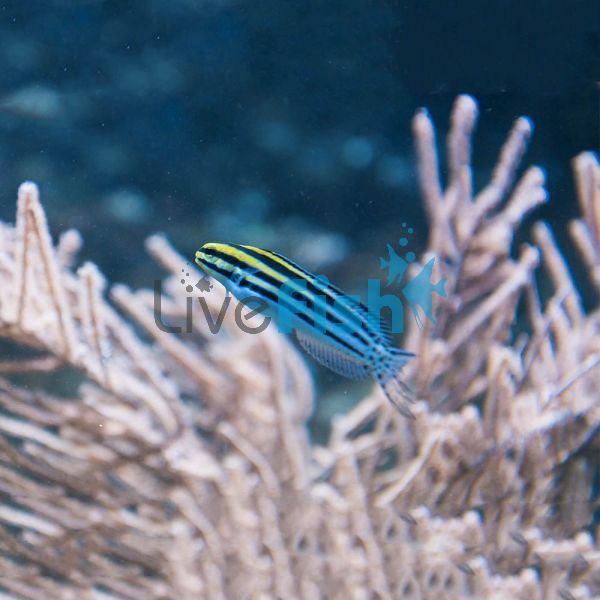Striped Poison Fang Blenny MED
The Striped Poison Fang Blenny is fantastic addition to a reef or fish only aquarium. It is a lively, attractive species, with a relaxed temperament.
Striped Poison Fang Blenny
The Striped Poison Fang Blenny has colouring that is believed to be aposematic. In other words, it warns off potential predators due to its venomous fangs. Despite this, it isn't dangerous for other tank members unless they are of a similar size or shape. The only risk to humans is if they have an allergy to venom. People who are susceptible to reactions from wasp or bee stings may be more likely to react. For most people, it should cause no more than localized pain. They have a small mouth which reduces the chance of venom being delivered in a bite. The Striped Poison Fang Blenny is white with black stripes running along its body.
These stripes change to black dots towards the tail. The white body can develop a yellow tinge towards the front of the body and head. The yellow continues up the front of the dorsal fin. The remainder of the dorsal fin is bluish with a black line running along the top. The tailfin is also bluish with a black stripe at the top and bottom. Black dots continue from the rear of the body over the middle of the tailfin.
Striped Poison Fang Blennies have occasionally been bred in captivity. This does appear to be a rarity and there is more success with other Meiacanthus species. It is possible to distinguish the sexes, males tend to have larger caudal and pelvic fins. The males' caudal fin may also have extensions on its edge. If attempting to breed in captivity, a nest can be created using a PVC tube as the males’ hiding place.
It will attract the female who will enter and deposit eggs for the male to fertilize. The male then looks after the eggs for around 2 weeks before they hatch. Larvae should initially be fed rotifers and later Artemia nauplii as they develop.
This species is native to the Western Pacific area. Recorded in locations such as Indonesia, Papua New Guinea, Southern Japan, and Australia. They can be found in sheltered areas of lagoons and reefs, usually to a depth of 20 meters.
Tank Recommendations for your Striped Poison Fang Blenny
Striped Poison Fang Blennies should be housed in a tank that is at least 30 gallons (113.5 litres) capacity.
Both reef and fish-only aquariums are suitable for this species. Any aquarium you introduce it to will need to have plenty of live rock. As well as offering places to hide it also provides feeding opportunities.
An established aquarium is a preferable environment as it provides a micro-life food source. This allows the Striped Poison Fang Blenny to source its' own food. They are able to jump from a tank, so a secure lid is advisable.
Suitable Tank Buddies
Striped Poison Fang Blennies are semi-aggressive, but peaceful overall. They won't normally be aggressive unless co-habiting with fish of a similar shape or size.
If it does use its fangs, it is usually in defense, when aggressive fish harass it or encroach its territory.
Usually Compatible
Striped Poison Fang Blennies are normally peaceful. Suitable tank mates include Angelfish, Clownfish, Filefish, Hawkfish, Puffers, and Tang/Surgeons.
Sometime Compatible
A larger tank will be needed if attempting to cohabit with conspecifics or fish of a similar size or shape. Fish that need monitoring include Basslets, Cardinalfish, Dragonets, Triggers, and fish-only Wrasse.
Rarely Compatible
Avoid Anglerfish/Frogfish, Eels, Groupers, Lionfish/Scorpionfish, Sharks, and Rays as they are all likely to try and eat it. Seahorses and Pipefish are also unsuitable as they are fragile and easily stressed.
Feeding your Striped Poison Fang Blenny
Striped Poison Fang Blennies are omnivores. They will consume, chopped crustaceans, vitamin-enriched Brine Shrimp, frozen Mysis, and Artemia. Freeze-dried & flake food is suitable as well as frozen herbivorous food preparations. They need to be fed 2-3 times per day.




